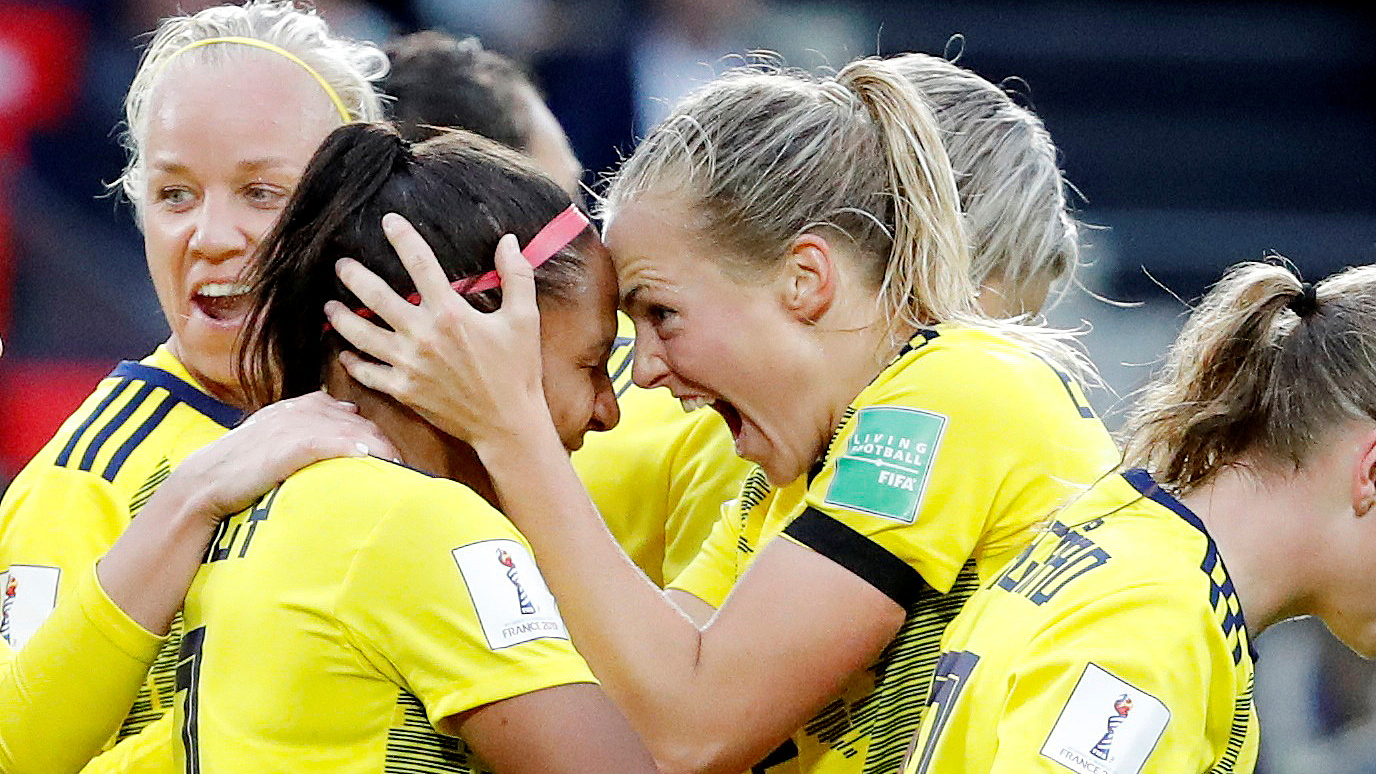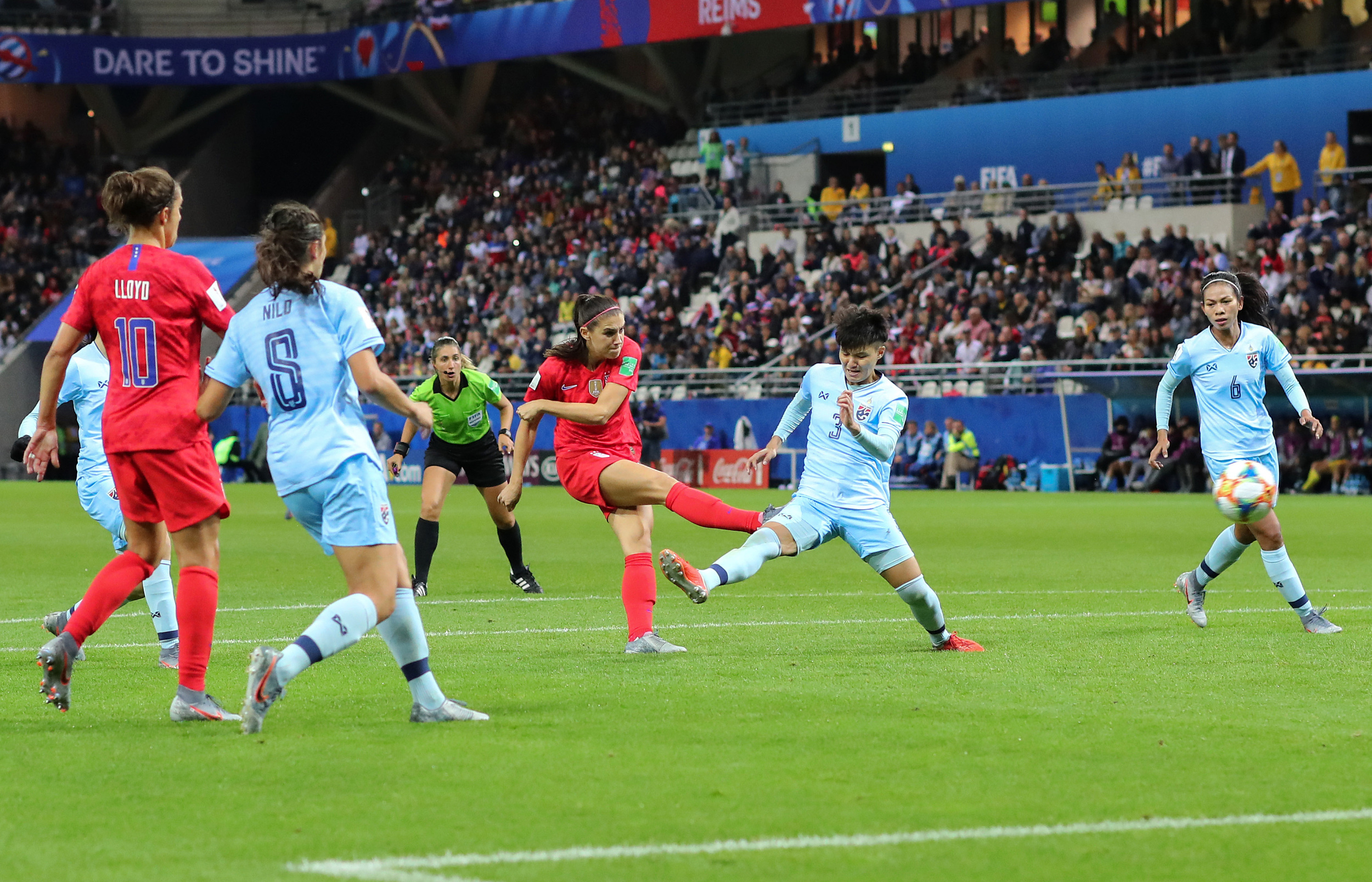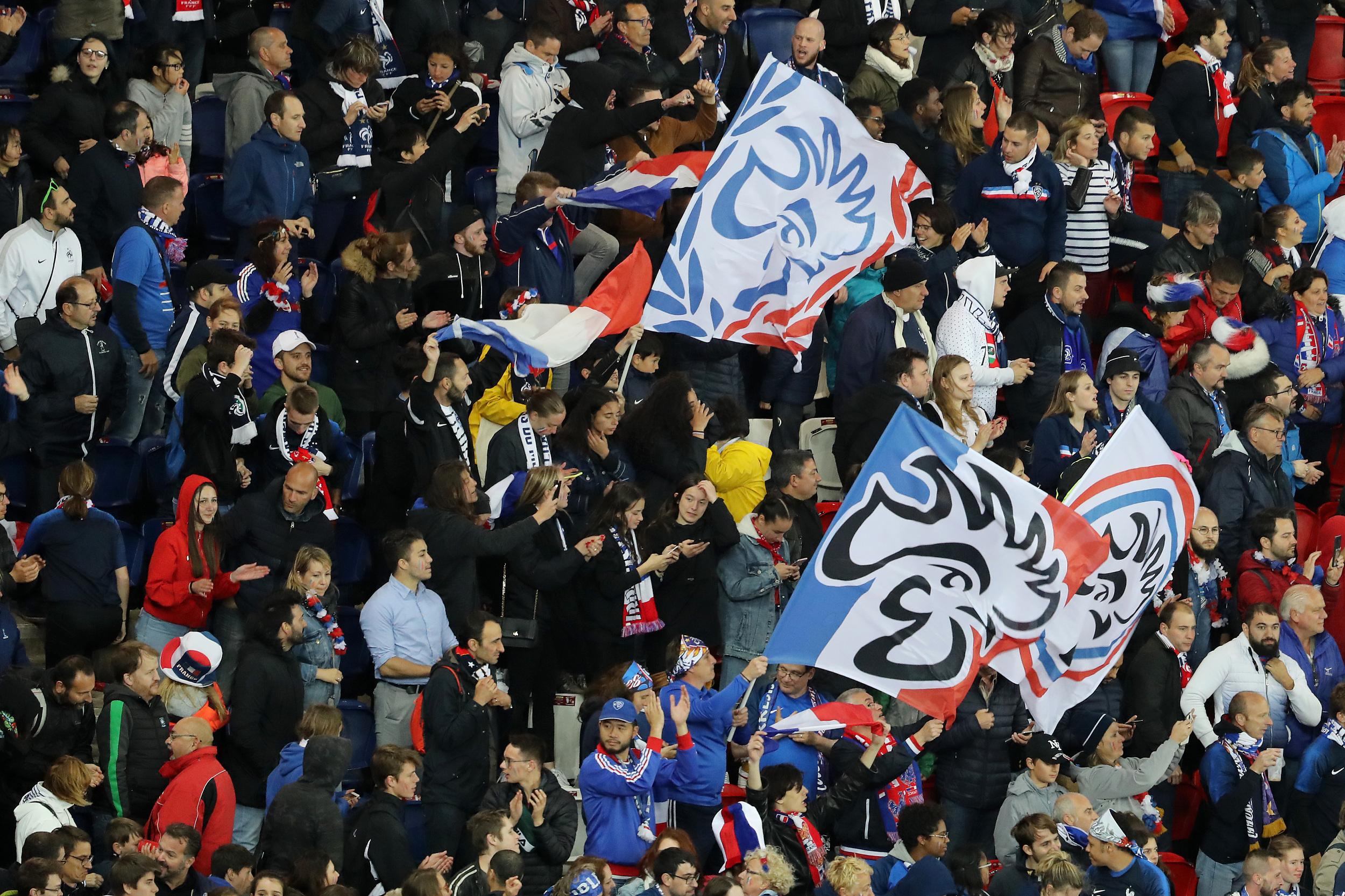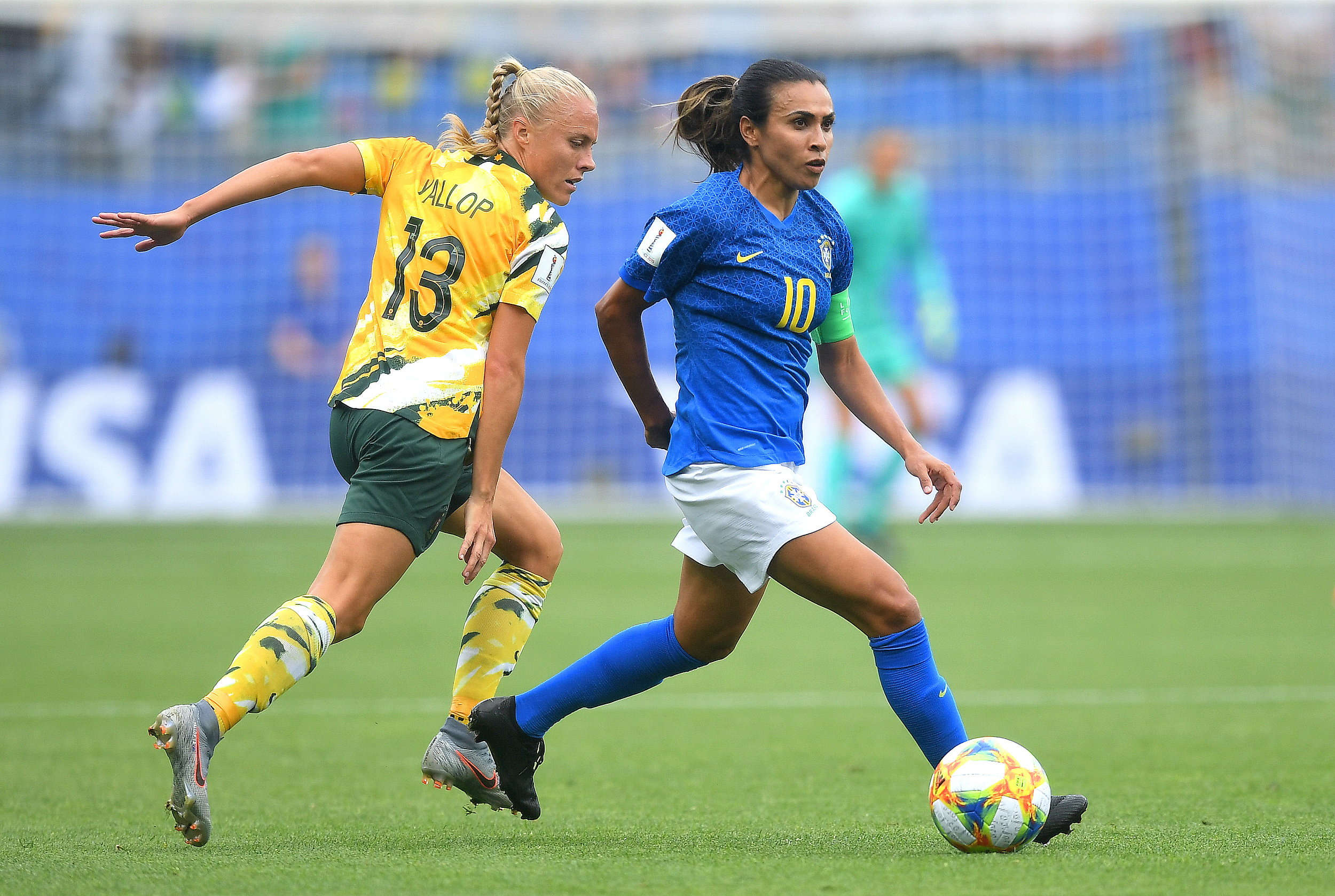

Sweden's Madelen Janogy (2nd, L) celebrates scoring with teammate Stephane Mahe in their 2019 FIFA Women's World Cup Group F match against Chile at Roazhon Park, Rennes, France, June 11, 2019. /VCG Photo
In the streets of Paris, many seem unaware a major tournament is going on. And yet, the Women's World Cup, which kicked off a week ago in France, has already attracted record viewers and major media coverage, while on social media, games, goals and players have been trending topics.
So are we seeing a breakthrough moment for women's football?
Record viewers
Over 9.8 million French viewers watched the opening game between host nation France and South Korea on June 7, more than for any women's football match in the past, according to national figures.
In Britain, England's 2-1 win over Scotland on Sunday drew a record 6.1 million TV viewers.
As of Tuesday, over one million tickets had been allocated to football fans worldwide, and 14 out of 52 games were completely sold out, including the final, both semi-finals, and all group matches featuring defending champions, the United States.
The U.S. ladies' 13-0 demolition of Thailand meanwhile made headlines around the world.

Fans of South Africa cheer prior to the 2019 FIFA Women's World Cup Group B match between South Africa and China at Parc des Princes, Paris, France, June 13, 2019. /VCG Photo
"It's a great thing that's happening," Simon Chadwick, a sports business expert and professor at Salford University, told CGTN. "This is an amazing time for women's football… certainly in England, people can name female players," something that has never been the case before.
"For the first time, the Women's World Cup is really more prominent than in the past."
FIFA support
None of this happened organically. Rather, there has been a concerted effort over the past few years to give women's sports more visibility, even as men's sports continue to enjoy bigger paychecks, investments and fan numbers.
"(People) think the rise in interest in women's sports is a natural phenomenon: that's wrong. It's because people have been fighting and pushing," Carole Oglesby, a long-time campaigner and former co-chair of the International Working Group on Women and Sport, told CGTN.

Alex Morgan scores the first of 13 goals for the U.S. during their 2019 FIFA Women's World Cup Group F match against Thailand at Stade Auguste Delaune in Reims, France, June 11, 2019. /VCG Photo
Under pressure from advocates, policy-makers made gender equality in sports a new priority, including in the UN's Sustainable Development Goals, the Kazan Action Plan and the International Olympic Committee's Gender Equality Review Project.
This in turn pushed governing bodies like FIFA, the hugely influential international football association, to take action and do more to promote the sport – although some may have done so halfheartedly.
"I don't think organizations have seen the light, but they think: 'Ok, this is something we have to do, to check the box'," said Oglesby.
Show me the money
A "feeding frenzy" on the part of corporate sponsors, looking for a new market, has also been crucial.
"Men's football is a mature product, a mature market, there's not a lot of opportunity for growth," Chadwick noted. "People seeking to generate revenue are looking for the next big thing".
Enter: women's football.
A sponsorship deal between the European football association UEFA and credit card company VISA in December was hailed as a milestone, the first for UEFA dedicated exclusively to women's football. British bank Barclays signed a 10-million-pound (12.7-million-U.S.-dollar) deal in March to sponsor the Women's Super League.

French fans celebrate during the 2019 FIFA Women's World Cup Group A match between France and South Korea at Parc des Princes, Paris, France, June 7, 2019. /VCG Photo
Big brands like Nike, Coca-Cola, Volkswagen, Samsung, TagHeuer and Budweiser have all associated themselves with the Women's World Cup or participating teams.
Credit goes to FIFA President Gianni Infantino's "keen eye for promoting equality while building revenue," Chadwick argued. "He built up coverage of the tournament, drew in new sponsors, and raised the profile of the women's game generally."
Besides organizational support and corporate backing, societal changes, including the MeToo movement, which has given women more of a voice and brought gender equality issues to the forefront, have also helped shine a brighter spotlight on this Women's World Cup.
A drop in the ocean
But whether the momentum continues is far from guaranteed.
Locals and tourists quizzed by CNN in the streets of Paris about what sports event was going on, almost all cited the tennis French Open and appeared clueless that the Women's World Cup was underway.
In the U.S., matches have been broadcast not on major sports network ESPN, but on ESPN W, its smaller sister channel dedicated to women's sports, Oglesby noted.
With commercial interests driving so much of the attention and publicity around the tournament, there is a risk this will drop if their investment doesn't pay off.

Marta of Brazil runs with the ball under pressure from Tameka Yallop of Australia during the 2019 FIFA Women's World Cup Group C match between Australia and Brazil at Stade de la Mosson, Montpellier, France, June 13, 2019. /VCG Photo
"I worry that it might just be a moment," said Chadwick. "If women's football doesn't deliver commercial results, they'll lose interest."
The key factor will be data. "Companies will need to see people are interested: that girls are playing and boys are watching," he said.
While the debate is often framed in terms of encouraging women to play and watch football, the big breakthrough will be whether men are also tuning in to see games. "It's not all about women, it's also about men's attitudes," said Chadwick.
For Oglesby, "it will be centuries" before women's sports achieve the same position as men's sports. Heads of governing bodies and club owners are still almost exclusively men. The biggest stars in women's football, like Ada Hegerberg, Marta and Alex Morgan, have nowhere near the same name recognition as Lionel Messi or Neymar. And while FIFA has set a target of one billion viewers at the 2019 Women's World Cup – up from 750 million in 2015 – the men's edition last year had three times as many.
Still, looking at the data, there have been "modest gains" for women's football, Oglesby admitted. And for those countries that do well in France, there is a strong chance that national interest in the sport will be piqued.
It is up to companies, FIFA and national footballing associations to keep the ball rolling. "This can't be just a moment... it has to be sustained," said Chadwick.

Copyright © 2018 CGTN. Beijing ICP prepared NO.16065310-3
Copyright © 2018 CGTN. Beijing ICP prepared NO.16065310-3